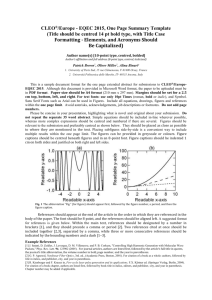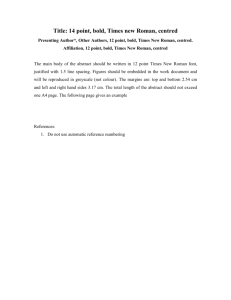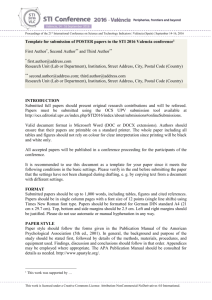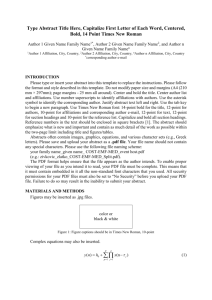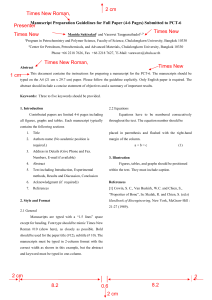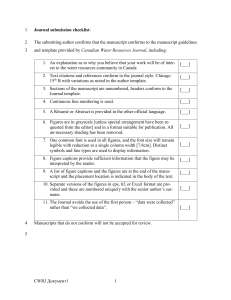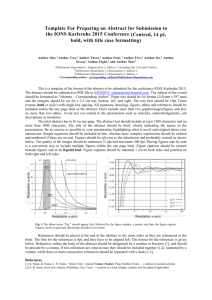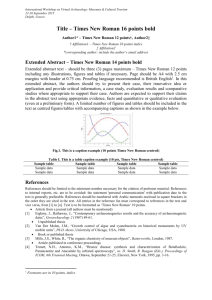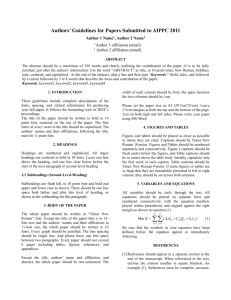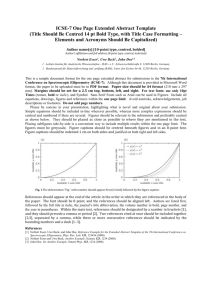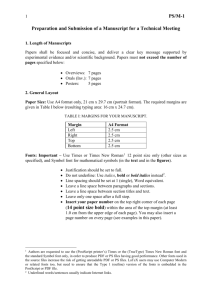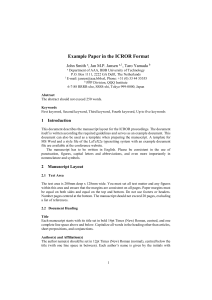ISSI 2015 Template
advertisement
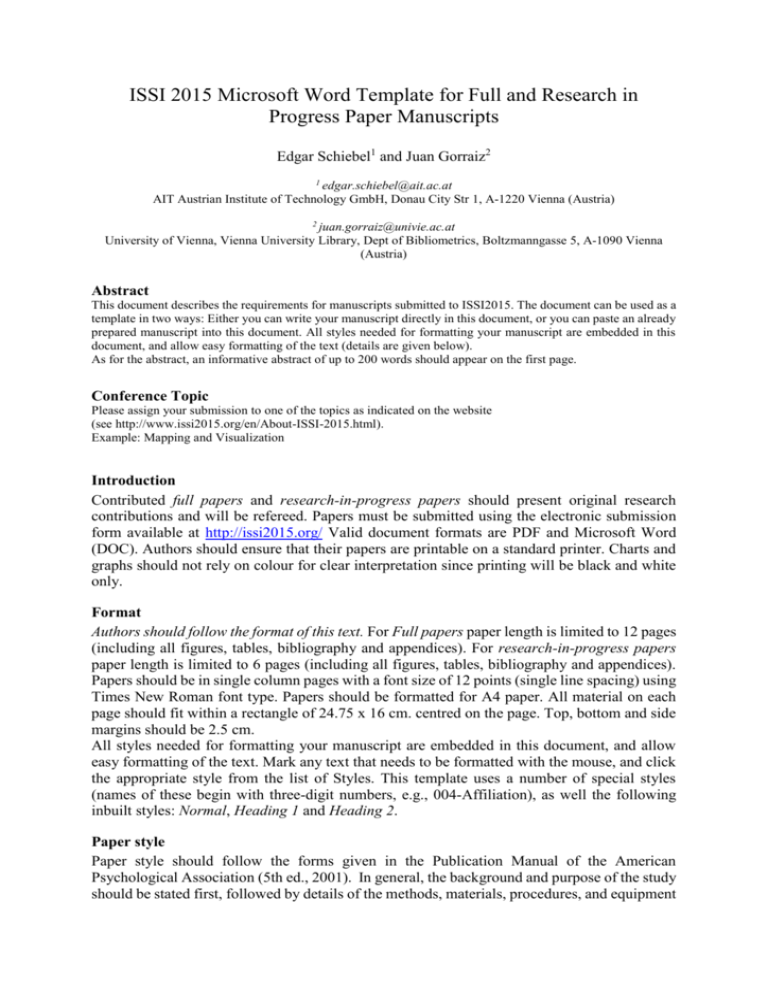
ISSI 2015 Microsoft Word Template for Full and Research in Progress Paper Manuscripts Edgar Schiebel1 and Juan Gorraiz2 1 edgar.schiebel@ait.ac.at AIT Austrian Institute of Technology GmbH, Donau City Str 1, A-1220 Vienna (Austria) 2 juan.gorraiz@univie.ac.at University of Vienna, Vienna University Library, Dept of Bibliometrics, Boltzmanngasse 5, A-1090 Vienna (Austria) Abstract This document describes the requirements for manuscripts submitted to ISSI2015. The document can be used as a template in two ways: Either you can write your manuscript directly in this document, or you can paste an already prepared manuscript into this document. All styles needed for formatting your manuscript are embedded in this document, and allow easy formatting of the text (details are given below). As for the abstract, an informative abstract of up to 200 words should appear on the first page. Conference Topic Please assign your submission to one of the topics as indicated on the website (see http://www.issi2015.org/en/About-ISSI-2015.html). Example: Mapping and Visualization Introduction Contributed full papers and research-in-progress papers should present original research contributions and will be refereed. Papers must be submitted using the electronic submission form available at http://issi2015.org/ Valid document formats are PDF and Microsoft Word (DOC). Authors should ensure that their papers are printable on a standard printer. Charts and graphs should not rely on colour for clear interpretation since printing will be black and white only. Format Authors should follow the format of this text. For Full papers paper length is limited to 12 pages (including all figures, tables, bibliography and appendices). For research-in-progress papers paper length is limited to 6 pages (including all figures, tables, bibliography and appendices). Papers should be in single column pages with a font size of 12 points (single line spacing) using Times New Roman font type. Papers should be formatted for A4 paper. All material on each page should fit within a rectangle of 24.75 x 16 cm. centred on the page. Top, bottom and side margins should be 2.5 cm. All styles needed for formatting your manuscript are embedded in this document, and allow easy formatting of the text. Mark any text that needs to be formatted with the mouse, and click the appropriate style from the list of Styles. This template uses a number of special styles (names of these begin with three-digit numbers, e.g., 004-Affiliation), as well the following inbuilt styles: Normal, Heading 1 and Heading 2. Paper style Paper style should follow the forms given in the Publication Manual of the American Psychological Association (5th ed., 2001). In general, the background and purpose of the study should be stated first, followed by details of the methods, materials, procedures, and equipment used. Findings, discussion and conclusions should follow in that order. Appendices may be employed where appropriate. The APA Publication Manual should be consulted for details as needed (http://www.apastyle.org/). Paper layout First page The first page must contain the title of the paper (Style: 001-Title, 16 point type, centred, Times Roman font) and only for accepted contributions the authors’ names, email addresses, affiliation and mailing addresses, all centred (Styles 002 to 004). Notes should be given as endnotes; footnotes should be avoided. An informative abstract of 200 words or less should be included on the first page. Subsequent pages Right margins should be justified, not ragged. Tables and figures should be incorporated in the text. Sections Sections should not be numbered. First level section headings should be in 12-point Times New Roman, bold face (Style: Heading 1) with subsections in 12-point italic Times New Roman (Style: Heading 2). Tables and Figures Tables and figures should be incorporated in the text as close to the reference as possible and should be in a form suitable for publication when printed with a good quality laser printer. Figures will be printed in black and white and should be readily interpreted without the use of colour. Captions should be Times New Roman 11-point, centred and bold. Tables and figures should be sequentially numbered in separate series. Captions for tables should be above the table. Captions for figures should be below the figure. Table 1. Table captions should be 11 point bold type, centred and placed above the table (Style: 007-Caption). Include a single empty line in the Normal style after the table. Table Item 1 Item 2 Header Aaa Ddd Header 2 Bbb Eee Header 3 Ccc Fff Figures, e.g., a diagram, must be inserted as a pure ‘image’ using the Word ‘Insert special’ option in the ‘Editing’ menu. The image should be fixed in relation to the text body by using the ‘Image’ option in the ‘Format’ menu. From the ‘Image’ option one selects the ‘Layout’ entry, followed by the ‘In-line-with-text’ option and carriage return. In Office 2007, insert the Image using the ‘Paste Special...’ function accessible from under the Paste icon on the Home pane. Sections should not be numbered. First level section headings should be in 12-point Times New Roman, bold face with subsections in 12-point italic Times New Roman. References and Citations The accuracy and completeness of the references is the responsibility of the author. References to personal letters, paper presented at meetings, and other unpublished material may be included. The format for citations in text for bibliographic references follows the Publication Manual of the American Psychological Association (5th ed., 2001). Citation of an author's work in the text should follow the author-date method of citation; the surname of the author(s), maximum three, and the year of publication should appear in text. For example, “Smith (1999) found that…”; “other researchers (Black, Duck & Tan, 2000) …”. Formats for citation of electronic references are given on the APA web site: http://www.apastyle.org/elecref.html. References in 11-point type should be listed alphabetically at the end of the paper using an unnumbered style with a 0.5 cm hanging indentation (see below). Data 170 160 150 140 130 Data 120 110 100 90 2000 2001 2002 2003 2004 2005 2006 2007 2008 2009 Figure 1. Figure captions should be 11 point bold type, centred and placed below the figure (Style: 007-Caption). Include a single empty line in the Normal style before the figure. Acknowledgments Acknowledgments can be given in a separate section immediately preceding the references. This template is inspired by and practically copied from the ISSI2009 template published by Birger Larssen and Jacqueline Leta. References Buckland, M. & Gey, F. (1994). The relationship between recall and precision. Journal of the American Society for Information Science, 45, 12-19. Borgman, C.L. (Ed.). (1990). Scholarly Communication and Bibliometrics. London: Sage. Bauin, S. & Rothman, H. (1992). "Impact" of journals as proxies for citation counts. In P. Weingart, R. Sehringer & M. Winterhager (Eds.), Representations of Science and Technology (pp. 225-239). Leiden: DSWO Press. Hoppe, K., Ammersbach, K., Lutes-Schaab, B. & Zinssmeister, G. (1990). EXPRESS: An experimental interface for factual information retrieval. In J.-L. Vidick (Ed.), Proceedings of the 13th International Conference on Research and Development in Information Retrieval (ACM SIGIR '91) (pp. 63-81). Brussels: ACM. Kling, R. & Elliott, M. (1994). Digital library design for usability. Retrieved December 7, 2001 from: http://www.csdl.tamu.edu/DL94/paper/kling.html.
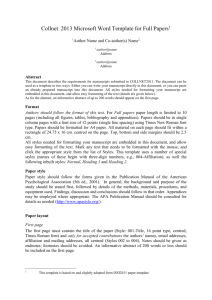
![Template for submission of full papers to the STI 2013 conference[1]](http://s3.studylib.net/store/data/007704708_2-d6c8e2180f4e534427e4dfe4ad5e09cc-300x300.png)
